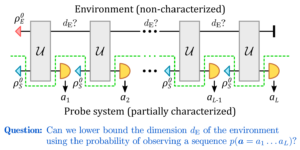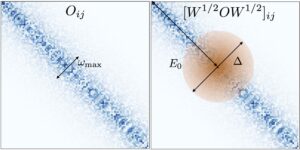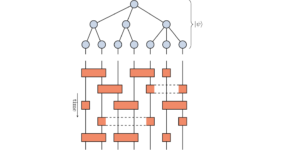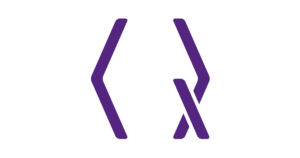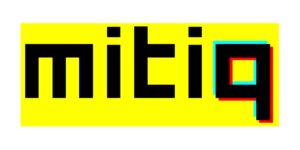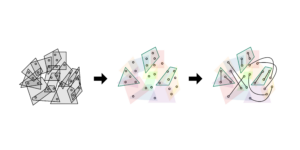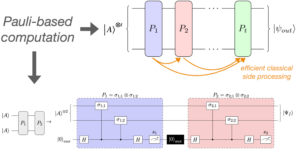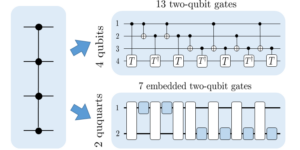1Department of Physics and Institute for Quantum Information and Matter, California Institute of Technology, Pasadena, California 91125, USA
2The Abdus Salam International Centre for Theoretical Physics (ICTP), strada Costiera 11, 34151 Trieste, Italy
3International School for Advanced Studies (SISSA), via Bonomea 265, 34136 Trieste, Italy
4Department of Physics, University of Trieste, 34127 Trieste, Italy
5Istituto Nazionale di Ottica del Consiglio Nazionale delle Ricerche (CNR-INO), 34149 Basovizza-Trieste, Italy
Find this paper interesting or want to discuss? Scite or leave a comment on SciRate.
Abstract
We propose a protocol for the scalable quantum simulation of SU($N$)$times$U(1) lattice gauge theories with alkaline-earth like atoms in optical lattices in both one- and two-dimensional systems. The protocol exploits the combination of naturally occurring SU($N$) pseudo-spin symmetry and strong inter-orbital interactions that is unique to such atomic species. A detailed ab initio study of the microscopic dynamics shows how gauge invariance emerges in an accessible parameter regime, and allows us to identify the main challenges in the simulation of such theories. We provide quantitative results about the requirements in terms of experimental stability in relation to observing gauge invariant dynamics, a key element for a deeper analysis on the functioning of such class of theories in both quantum simulators and computers.
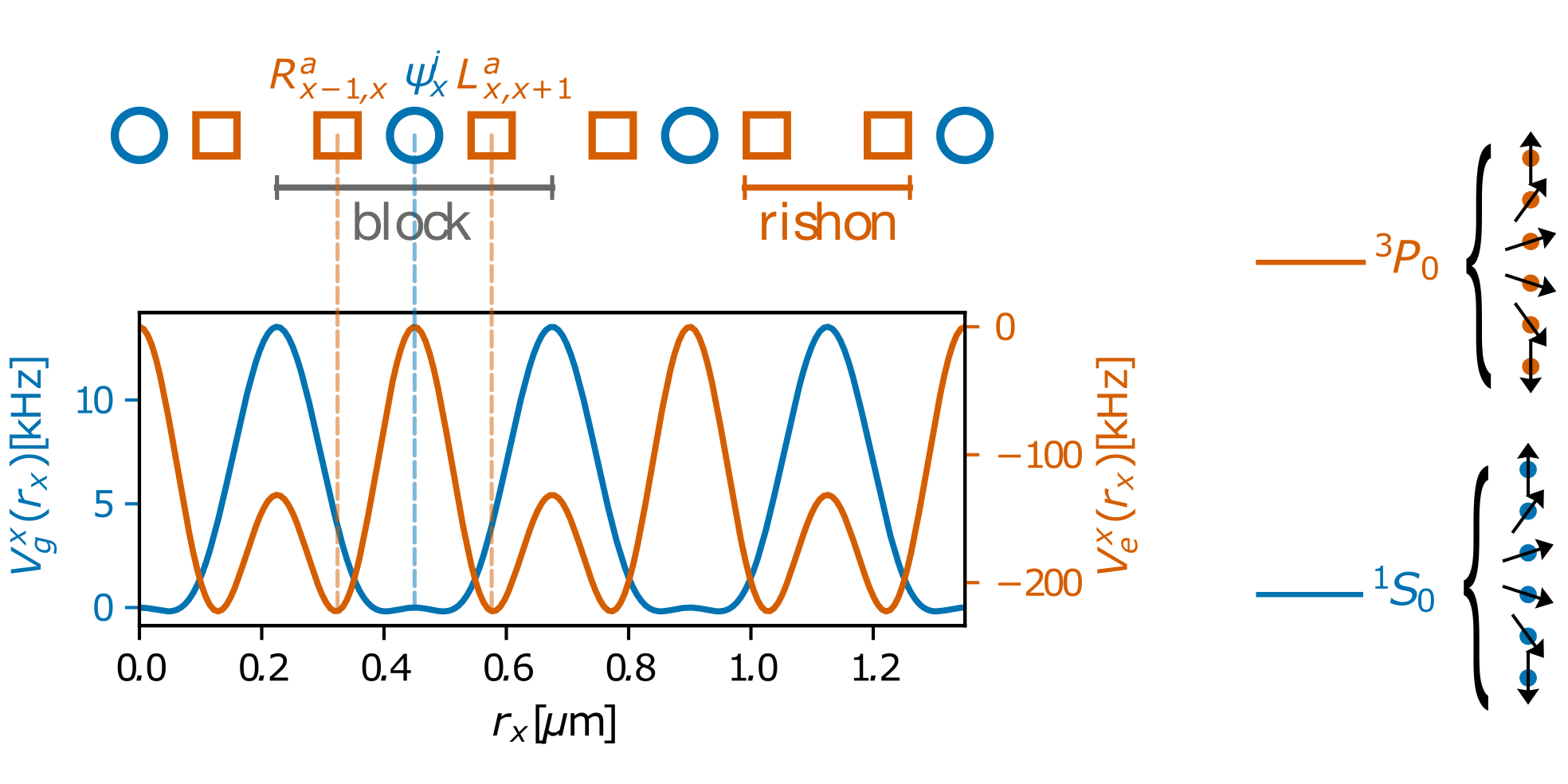
Featured image: Scheme of the 1+1d Quantum Link Model: fermionic matter (in blue) resides on the sites of a one-dimensional lattice; the gauge field is represented by fermionic operators (rishons) that act on the two ends of a link (in orange). The matter/gauge sites correspond to the minima of an optical lattice for alkaline-earth-like atoms in the $g/e$ state respectively. The $g/e$ states correspond to the electronic ground state (${}^1S_0$) and metastable clock state (${}^3P_0$) of the atoms. There are $N_I$ nuclear spin states decoupled from the electronic degrees of freedom.
Popular summary
By harnessing the unique properties of alkaline-earth-like atoms in optical lattices, we propose a method for quantum simulating non-Abelian SU(N)xU(1) lattice gauge theories. Our protocol capitalizes on the inherent SU(N) pseudo-spin symmetry and strong inter-orbital interactions of these atoms. Through an ab initio study, we unveil how gauge invariance naturally emerges within experimentally feasible parameters. This not only sheds light on the behavior of such theories but also outlines the hurdles one must overcome for successful simulation.
Our results lay the groundwork for deeper insights into the study of non-Abelian gauge theories using quantum simulators.
► BibTeX data
► References
[1] Uwe Jens Wiese. “Ultracold quantum gases and lattice systems: Quantum simulation of lattice gauge theories”. Annalen der Physik 525, 777–796 (2013). arXiv:1305.1602.
https://doi.org/10.1002/andp.201300104
arXiv:1305.1602
[2] John Preskill. “Simulating quantum field theory with a quantum computer” (2018). url: arxiv.org/abs/1811.10085.
arXiv:1811.10085
[3] Erez Zohar, J Ignacio Cirac, and Benni Reznik. “Quantum simulations of lattice gauge theories using ultracold atoms in optical lattices”. Reports on Progress in Physics 79, 014401 (2015).
https://doi.org/10.1088/0034-4885/79/1/014401
[4] M. Dalmonte and S. Montangero. “Lattice gauge theories simulations in the quantum information era”. Contemp. Phys. 57, 388 (2016).
https://doi.org/10.1080/00107514.2016.1151199
[5] Mari Carmen Bañuls, Rainer Blatt, Jacopo Catani, Alessio Celi, Juan Ignacio Cirac, Marcello Dalmonte, Leonardo Fallani, Karl Jansen, Maciej Lewenstein, Simone Montangero, and et al. “Simulating lattice gauge theories within quantum technologies”. The European Physical Journal D 74 (2020).
https://doi.org/10.1140/epjd/e2020-100571-8
[6] Christian W. Bauer, Zohreh Davoudi, A. Baha Balantekin, Tanmoy Bhattacharya, Marcela Carena, Wibe A. de Jong, Patrick Draper, Aida El-Khadra, Nate Gemelke, Masanori Hanada, Dmitri Kharzeev, Henry Lamm, Ying-Ying Li, Junyu Liu, Mikhail Lukin, Yannick Meurice, Christopher Monroe, Benjamin Nachman, Guido Pagano, John Preskill, Enrico Rinaldi, Alessandro Roggero, David I. Santiago, Martin J. Savage, Irfan Siddiqi, George Siopsis, David Van Zanten, Nathan Wiebe, Yukari Yamauchi, Kübra Yeter-Aydeniz, and Silvia Zorzetti. “Quantum simulation for high-energy physics”. PRX Quantum 4, 027001 (2023).
https://doi.org/10.1103/PRXQuantum.4.027001
[7] I. Montvay and G. Muenster. “Quantum Fields on a lattice”. Cambridge Univ. Press, Cambridge. (1994).
https://doi.org/10.1017/CBO9780511470783
[8] Kenji Fukushima and Tetsuo Hatsuda. “The phase diagram of dense QCD”. Rep. Progr. Phys. 74, 014001 (2010).
https://doi.org/10.1088/0034-4885/74/1/014001
[9] R.A. Soltz, C. DeTar, F. Karsch, Swagato Mukherjee, and P. Vranas. “Lattice QCD thermodynamics with physical quark masses”. Annual Review of Nuclear and Particle Science 65, 379–402 (2015).
https://doi.org/10.1146/annurev-nucl-102014-022157
[10] Zoltan Fodor and Christian Hoelbling. “Light hadron masses from lattice QCD”. Rev. Mod. Phys. 84, 449–495 (2012).
https://doi.org/10.1103/RevModPhys.84.449
[11] E. A. Martinez, C. A. Muschik, P. Schindler, D. Nigg, A. Erhard, M. Heyl, P. Hauke, M. Dalmonte, T. Monz, P. Zoller, and R. Blatt. “Real-time dynamics of lattice gauge theories with a few-qubit quantum computer”. Nature 534, 516 (2016).
https://doi.org/10.1038/nature18318
[12] Marco Anderlini, Patricia J. Lee, Benjamin L. Brown, Jennifer Sebby-Strabley, William D. Phillips, and J. V. Porto. “Controlled exchange interaction between pairs of neutral atoms in an optical lattice”. Nature 448, 452–456 (2007).
https://doi.org/10.1038/nature06011
[13] S. Trotzky, P. Cheinet, S. Folling, M. Feld, U. Schnorrberger, A. M. Rey, A. Polkovnikov, E. A. Demler, M. D. Lukin, and I. Bloch. “Time-resolved observation and control of superexchange interactions with ultracold atoms in optical lattices”. Science 319, 295–299 (2008).
https://doi.org/10.1126/science.1150841
[14] Christian Schweizer, Fabian Grusdt, Moritz Berngruber, Luca Barbiero, Eugene Demler, Nathan Goldman, Immanuel Bloch, and Monika Aidelsburger. “Floquet approach to Z$_2$ lattice gauge theories with ultracold atoms in optical lattices”. Nature Physics 15, 1168–1173 (2019).
https://doi.org/10.1038/s41567-019-0649-7
[15] Alexander Mil, Torsten V. Zache, Apoorva Hegde, Andy Xia, Rohit P. Bhatt, Markus K. Oberthaler, Philipp Hauke, Jürgen Berges, and Fred Jendrzejewski. “A scalable realization of local U(1) gauge invariance in cold atomic mixtures”. Science 367, 1128–1130 (2020).
https://doi.org/10.1126/science.aaz5312
[16] Bing Yang, Hui Sun, Robert Ott, Han-Yi Wang, Torsten V. Zache, Jad C. Halimeh, Zhen-Sheng Yuan, Philipp Hauke, and Jian-Wei Pan. “Observation of gauge invariance in a 71-site Bose–Hubbard quantum simulator”. Nature 587, 392–396 (2020).
https://doi.org/10.1038/s41586-020-2910-8
[17] Hannes Bernien, Sylvain Schwartz, Alexander Keesling, Harry Levine, Ahmed Omran, Hannes Pichler, Soonwon Choi, Alexander S Zibrov, Manuel Endres, Markus Greiner, et al. “Probing many-body dynamics on a 51-atom quantum simulator”. Nature 551, 579 (2017).
https://doi.org/10.1038/nature24622
[18] Zhao-Yu Zhou, Guo-Xian Su, Jad C Halimeh, Robert Ott, Hui Sun, Philipp Hauke, Bing Yang, Zhen-Sheng Yuan, Jürgen Berges, and Jian-Wei Pan. “Thermalization dynamics of a gauge theory on a quantum simulator”. Science 377, 311–314 (2022).
https://doi.org/10.1126/science.abl6277
[19] Roland C Farrell, Marc Illa, Anthony N Ciavarella, and Martin J Savage. “Scalable circuits for preparing ground states on digital quantum computers: The Schwinger model vacuum on 100 qubits” (2023). arXiv:2308.04481.
arXiv:2308.04481
[20] Natalie Klco, Martin J. Savage, and Jesse R. Stryker. “SU(2) non-Abelian gauge field theory in one dimension on digital quantum computers”. Phys. Rev. D 101, 074512 (2020).
https://doi.org/10.1103/PhysRevD.101.074512
[21] Yasar Y Atas, Jinglei Zhang, Randy Lewis, Amin Jahanpour, Jan F Haase, and Christine A Muschik. “SU (2) hadrons on a quantum computer via a variational approach”. Nature communications 12, 6499 (2021).
https://doi.org/10.1038/s41467-021-26825-4
[22] Anthony Ciavarella, Natalie Klco, and Martin J. Savage. “Trailhead for quantum simulation of su(3) yang-mills lattice gauge theory in the local multiplet basis”. Phys. Rev. D 103, 094501 (2021).
https://doi.org/10.1103/PhysRevD.103.094501
[23] D. Banerjee, M. Bögli, M. Dalmonte, E. Rico, P. Stebler, U.-J. Wiese, and P. Zoller. “Atomic Quantum Simulation of U(N) and SU(N) Non-Abelian Lattice Gauge Theories”. Physical Review Letters 110, 125303 (2013).
https://doi.org/10.1103/PhysRevLett.110.125303
[24] Erez Zohar, J. Ignacio Cirac, and Benni Reznik. “Cold-atom quantum simulator for SU(2) Yang-Mills lattice gauge theory”. Phys. Rev. Lett. 110, 125304 (2013).
https://doi.org/10.1103/PhysRevLett.110.125304
[25] Erez Zohar, J. Ignacio Cirac, and Benni Reznik. “Quantum simulations of gauge theories with ultracold atoms: Local gauge invariance from angular-momentum conservation”. Phys. Rev. A 88, 023617 (2013).
https://doi.org/10.1103/PhysRevA.88.023617
[26] L. Tagliacozzo, A. Celi, P. Orland, M. W. Mitchell, and M. Lewenstein. “Simulation of non-Abelian gauge theories with optical lattices”. Nature Communications 4 (2013).
https://doi.org/10.1038/ncomms3615
[27] E. Rico, M. Dalmonte, P. Zoller, D. Banerjee, M. Bögli, P. Stebler, and U.-J. Wiese. “SO(3) “nuclear physics” with ultracold gases”. Annals of Physics 393, 466–483 (2018).
https://doi.org/10.1016/j.aop.2018.03.020
[28] Julian Bender, Erez Zohar, Alessandro Farace, and J Ignacio Cirac. “Digital quantum simulation of lattice gauge theories in three spatial dimensions”. New Journal of Physics 20, 093001 (2018).
https://doi.org/10.1088/1367-2630/aadb71
[29] Valentin Kasper, Torsten V. Zache, Fred Jendrzejewski, Maciej Lewenstein, and Erez Zohar. “Non-Abelian gauge invariance from dynamical decoupling”. Phys. Rev. D 107, 014506 (2023).
https://doi.org/10.1103/PhysRevD.107.014506
[30] Valentin Kasper, Gediminas Juzeliūnas, Maciej Lewenstein, Fred Jendrzejewski, and Erez Zohar. “From the jaynes–cummings model to non-abelian gauge theories: a guided tour for the quantum engineer”. New Journal of Physics 22, 103027 (2020).
https://doi.org/10.1088/1367-2630/abb961
[31] Emil Mathew and Indrakshi Raychowdhury. “Protecting local and global symmetries in simulating $(1+1)mathrm{D}$ non-abelian gauge theories”. Phys. Rev. D 106, 054510 (2022).
https://doi.org/10.1103/PhysRevD.106.054510
[32] Daniel González-Cuadra, Torsten V. Zache, Jose Carrasco, Barbara Kraus, and Peter Zoller. “Hardware efficient quantum simulation of non-abelian gauge theories with qudits on rydberg platforms”. Phys. Rev. Lett. 129, 160501 (2022).
https://doi.org/10.1103/PhysRevLett.129.160501
[33] Jad C Halimeh, Lukas Homeier, Annabelle Bohrdt, and Fabian Grusdt. “Spin exchange-enabled quantum simulator for large-scale non-Abelian gauge theories” (2023). arXiv:2305.06373.
arXiv:2305.06373
[34] F Scazza, C Hofrichter, M Höfer, P. C. De Groot, I Bloch, and S Fölling. “Observation of two-orbital spin-exchange interactions with ultracold SU(N)-symmetric fermions”. Nature Phys. 10, 779–784 (2014).
https://doi.org/10.1038/nphys3061
[35] G. Cappellini, M. Mancini, G. Pagano, P. Lombardi, L. Livi, M. Siciliani de Cumis, P. Cancio, M. Pizzocaro, D. Calonico, F. Levi, C. Sias, J. Catani, M. Inguscio, and L. Fallani. “Direct observation of coherent interorbital spin-exchange dynamics”. Phys. Rev. Lett. 113, 120402 (2014).
https://doi.org/10.1103/PhysRevLett.113.120402
[36] M. Höfer, L. Riegger, F. Scazza, C. Hofrichter, D. R. Fernandes, M. M. Parish, J. Levinsen, I. Bloch, and S. Fölling. “Observation of an orbital interaction-induced feshbach resonance in $^{173}mathrm{Yb}$”. Phys. Rev. Lett. 115, 265302 (2015).
https://doi.org/10.1103/PhysRevLett.115.265302
[37] Christian Hofrichter, Luis Riegger, Francesco Scazza, Moritz Höfer, Diogo Rio Fernandes, Immanuel Bloch, and Simon Fölling. “Direct probing of the Mott crossover in the $mathrm{SU}(N)$ Fermi-Hubbard model”. Phys. Rev. X 6, 021030 (2016).
https://doi.org/10.1103/PhysRevX.6.021030
[38] L. F. Livi, G. Cappellini, M. Diem, L. Franchi, C. Clivati, M. Frittelli, F. Levi, D. Calonico, J. Catani, M. Inguscio, and L. Fallani. “Synthetic dimensions and spin-orbit coupling with an optical clock transition”. Phys. Rev. Lett. 117, 220401 (2016).
https://doi.org/10.1103/PhysRevLett.117.220401
[39] S. L. Campbell, R. B. Hutson, G. E. Marti, A. Goban, N. Darkwah Oppong, R. L. McNally, L. Sonderhouse, J. M. Robinson, W. Zhang, B. J. Bloom, and J. Ye. “A Fermi-degenerate three-dimensional optical lattice clock”. Science 358, 90–94 (2017).
https://doi.org/10.1126/science.aam5538
[40] L. Riegger, N. Darkwah Oppong, M. Höfer, D. R. Fernandes, I. Bloch, and S. Fölling. “Localized magnetic moments with tunable spin exchange in a gas of ultracold fermions”. Phys. Rev. Lett. 120, 143601 (2018).
https://doi.org/10.1103/PhysRevLett.120.143601
[41] A. Goban, R. B. Hutson, G. E. Marti, S. L. Campbell, M. A. Perlin, P. S. Julienne, J. P. D’Incao, A. M. Rey, and J. Ye. “Emergence of multi-body interactions in a fermionic lattice clock”. Nature 563, 369–373 (2018).
https://doi.org/10.1038/s41586-018-0661-6
[42] Hideki Ozawa, Shintaro Taie, Yosuke Takasu, and Yoshiro Takahashi. “Antiferromagnetic spin correlation of $mathrm{SU}(mathcal{N})$ Fermi gas in an optical superlattice”. Phys. Rev. Lett. 121, 225303 (2018).
https://doi.org/10.1103/PhysRevLett.121.225303
[43] Ren Zhang, Yanting Cheng, Peng Zhang, and Hui Zhai. “Controlling the interaction of ultracold alkaline-earth atoms”. Nature Reviews Physics 2, 213–220 (2020).
https://doi.org/10.1038/s42254-020-0157-9
[44] Federica Maria Surace, Pierre Fromholz, Nelson Darkwah Oppong, Marcello Dalmonte, and Monika Aidelsburger. “Ab initio derivation of lattice-gauge-theory dynamics for cold gases in optical lattices”. PRX Quantum 4, 020330 (2023).
https://doi.org/10.1103/PRXQuantum.4.020330
[45] D. Horn. “Finite matrix models with continuous local gauge invariance”. Physics Letters B 100, 149–151 (1981).
https://doi.org/10.1016/0370-2693(81)90763-2
[46] Peter Orland and Daniel Rohrlich. “Lattice gauge magnets: Local isospin from spin”. Nuclear Physics B 338, 647–672 (1990).
https://doi.org/10.1016/0550-3213(90)90646-U
[47] R. Brower, S. Chandrasekharan, and U.-J. Wiese. “QCD as a quantum link model”. Physical Review D 60, 094502 (1999). arXiv:9704106.
https://doi.org/10.1103/PhysRevD.60.094502
arXiv:9704106
[48] S Chandrasekharan and U.-J Wiese. “Quantum link models: A discrete approach to gauge theories”. Nuclear Physics B 492, 455–471 (1997).
https://doi.org/10.1016/s0550-3213(97)80041-7
[49] Uwe-Jens Wiese. “From quantum link models to D-theory: a resource efficient framework for the quantum simulation and computation of gauge theories”. Philosophical Transactions of the Royal Society A 380, 20210068 (2022).
https://doi.org/10.1098/rsta.2021.0068
[50] Alexey Vyacheslavovich Gorshkov, M Hermele, V Gurarie, C Xu, Paul S Julienne, J Ye, Peter Zoller, Eugene Demler, Mikhail D Lukin, and AM Rey. “Two-orbital SU(N) magnetism with ultracold alkaline-earth atoms”. Nature Physics 6, 289–295 (2010).
https://doi.org/10.1038/nphys1535
[51] Jad C Halimeh and Philipp Hauke. “Stabilizing gauge theories in quantum simulators: a brief review” (2022). arXiv:2204.13709.
arXiv:2204.13709
[52] Jad C. Halimeh, Lukas Homeier, Christian Schweizer, Monika Aidelsburger, Philipp Hauke, and Fabian Grusdt. “Stabilizing lattice gauge theories through simplified local pseudogenerators”. Phys. Rev. Res. 4, 033120 (2022).
https://doi.org/10.1103/PhysRevResearch.4.033120
[53] Jad C Halimeh, Haifeng Lang, and Philipp Hauke. “Gauge protection in non-abelian lattice gauge theories”. New Journal of Physics 24, 033015 (2022).
https://doi.org/10.1088/1367-2630/ac5564
[54] Lukas Homeier, Annabelle Bohrdt, Simon Linsel, Eugene Demler, Jad C Halimeh, and Fabian Grusdt. “Realistic scheme for quantum simulation of $Z_2$ lattice gauge theories with dynamical matter in (2+1) D”. Communications Physics 6, 127 (2023).
https://doi.org/10.1038/s42005-023-01237-6
[55] X. Zhang, M. Bishof, S. L. Bromley, C. V. Kraus, M. S. Safronova, P. Zoller, A. M. Rey, and J. Ye. “Spectroscopic observation of SU(N)-symmetric interactions in Sr orbital magnetism”. Science 345, 1467–1473 (2014).
https://doi.org/10.1126/science.1254978
[56] M A Cazalilla, A F Ho, and M Ueda. “Ultracold gases of ytterbium: ferromagnetism and Mott states in an SU(6) Fermi system”. New Journal of Physics 11, 103033 (2009).
https://doi.org/10.1088/1367-2630/11/10/103033
[57] S. Kivelson. “Wannier functions in one-dimensional disordered systems: Application to fractionally charged solitons”. Phys. Rev. B 26, 4269–4277 (1982).
https://doi.org/10.1103/PhysRevB.26.4269
[58] Nicola Marzari and David Vanderbilt. “Maximally localized generalized Wannier functions for composite energy bands”. Physical Review B – Condensed Matter and Materials Physics 56 (1997).
https://doi.org/10.1103/PhysRevB.65.035109
[59] Koki Ono, Jun Kobayashi, Yoshiki Amano, Koji Sato, and Yoshiro Takahashi. “Antiferromagnetic interorbital spin-exchange interaction of Yb171”. Physical Review A 99, 032707 (2019).
https://doi.org/10.1103/PhysRevA.99.032707
[60] Oscar Bettermann, Nelson Darkwah Oppong, Giulio Pasqualetti, Luis Riegger, Immanuel Bloch, and Simon Fölling. “Clock-line photoassociation of strongly bound dimers in a magic-wavelength lattice” (2020). arXiv:2003.10599.
arXiv:2003.10599
[61] J. R. Schrieffer and P. A. Wolff. “Relation between the anderson and kondo hamiltonians”. Phys. Rev. 149, 491–492 (1966).
https://doi.org/10.1103/PhysRev.149.491
[62] Robert E. Shrock. “The phase structure of SU(2) $times$ U(1) lattice gauge theory”. Physics Letters B 162, 165–170 (1985).
https://doi.org/10.1016/0370-2693(85)91080-9
[63] Pietro Silvi, Enrique Rico, Marcello Dalmonte, Ferdinand Tschirsich, and Simone Montangero. “Finite-density phase diagram of a $(1+1)-d$ non-abelian lattice gauge theory with tensor networks”. Quantum 1, 9 (2017).
https://doi.org/10.22331/q-2017-04-25-9
[64] Christof Weitenberg, Manuel Endres, Jacob F. Sherson, Marc Cheneau, Peter Schauß, Takeshi Fukuhara, Immanuel Bloch, and Stefan Kuhr. “Single-spin addressing in an atomic mott insulator”. Nature 471, 319–324 (2011).
https://doi.org/10.1038/nature09827
[65] Christian Gross and Waseem S. Bakr. “Quantum gas microscopy for single atom and spin detection”. Nature Physics 17, 1316–1323 (2021).
https://doi.org/10.1038/s41567-021-01370-5
[66] S. Trotzky, P. Cheinet, S. Fölling, M. Feld, U. Schnorrberger, A. M. Rey, A. Polkovnikov, E. A. Demler, M. D. Lukin, and I. Bloch. “Time-resolved observation and control of superexchange interactions with ultracold atoms in optical lattices”. Science 319, 295–299 (2008).
https://doi.org/10.1126/science.1150841
[67] Jad C. Halimeh and Philipp Hauke. “Reliability of lattice gauge theories”. Phys. Rev. Lett. 125, 030503 (2020).
https://doi.org/10.1103/PhysRevLett.125.030503
[68] Nilanjana Datta, Jürg Fröhlich, Luc Rey-Bellet, and Roberto Fernández. “Low-temperature phase diagrams of quantum lattice systems. ii. convergent perturbation expansions and stability in systems with infinite degeneracy”. Helvetica Physica Acta 69, 752–820 (1996).
[69] Sergey Bravyi, David P. DiVincenzo, and Daniel Loss. “Schrieffer–wolff transformation for quantum many-body systems”. Annals of Physics 326, 2793–2826 (2011).
https://doi.org/10.1016/j.aop.2011.06.004
[70] A. H. MacDonald, S. M. Girvin, and D. Yoshioka. “$frac{t}{U}$ expansion for the hubbard model”. Phys. Rev. B 37, 9753–9756 (1988).
https://doi.org/10.1103/PhysRevB.37.9753
[71] K. Stannigel, P. Hauke, D. Marcos, M. Hafezi, S. Diehl, M. Dalmonte, and P. Zoller. “Constrained dynamics via the Zeno effect in quantum simulation: Implementing non-Abelian lattice gauge theories with cold atoms”. Phys. Rev. Lett. 112, 120406 (2014).
https://doi.org/10.1103/PhysRevLett.112.120406
[72] Pierpaolo Fontana, Joao C. Pinto Barros, and Andrea Trombettoni. “Quantum simulator of link models using spinor dipolar ultracold atoms”. Phys. Rev. A 107, 043312 (2023).
https://doi.org/10.1103/PhysRevA.107.043312
[73] Kevin Singh, Shraddha Anand, Andrew Pocklington, Jordan T. Kemp, and Hannes Bernien. “Dual-element, two-dimensional atom array with continuous-mode operation”. Phys. Rev. X 12, 011040 (2022).
https://doi.org/10.1103/PhysRevX.12.011040
[74] Thomas Uehlinger, Gregor Jotzu, Michael Messer, Daniel Greif, Walter Hofstetter, Ulf Bissbort, and Tilman Esslinger. “Artificial graphene with tunable interactions”. Phys. Rev. Lett. 111, 185307 (2013).
https://doi.org/10.1103/PhysRevLett.111.185307
Cited by
[1] Juan Polo, Wayne J. Chetcuti, Enrico C. Domanti, Philip Kitson, Andreas Osterloh, Francesco Perciavalle, Vijay Pal Singh, and Luigi Amico, “Perspective on new implementations of atomtronic circuits”, arXiv:2311.16257, (2023).
The above citations are from SAO/NASA ADS (last updated successfully 2024-05-24 03:09:55). The list may be incomplete as not all publishers provide suitable and complete citation data.
On Crossref’s cited-by service no data on citing works was found (last attempt 2024-05-24 03:09:53).
This Paper is published in Quantum under the Creative Commons Attribution 4.0 International (CC BY 4.0) license. Copyright remains with the original copyright holders such as the authors or their institutions.
- SEO Powered Content & PR Distribution. Get Amplified Today.
- PlatoData.Network Vertical Generative Ai. Empower Yourself. Access Here.
- PlatoAiStream. Web3 Intelligence. Knowledge Amplified. Access Here.
- PlatoESG. Carbon, CleanTech, Energy, Environment, Solar, Waste Management. Access Here.
- PlatoHealth. Biotech and Clinical Trials Intelligence. Access Here.
- Source: https://quantum-journal.org/papers/q-2024-05-23-1359/
- :is
- :not
- ][p
- 06
- 09
- 1
- 10
- 100
- 11
- 12
- 120
- 121
- 125
- 13
- 14
- 15%
- 16
- 17
- 19
- 1981
- 1985
- 1994
- 1996
- 1999
- 20
- 2008
- 2009
- 2011
- 2012
- 2013
- 2014
- 2015
- 2016
- 2017
- 2018
- 2019
- 2020
- 2021
- 2022
- 2023
- 22
- 2204
- 23
- 24
- 25
- 26%
- 27
- 28
- 29
- 30
- 31
- 32
- 33
- 35%
- 36
- 37
- 39
- 40
- 41
- 43
- 49
- 491
- 50
- 51
- 53
- 54
- 58
- 60
- 65
- 66
- 67
- 69
- 7
- 70
- 72
- 8
- 84
- 9
- 97
- a
- About
- above
- ABSTRACT
- access
- accessible
- Act
- addressing
- advanced
- affiliations
- ahmed
- AL
- Alexander
- All
- allows
- also
- am
- an
- analysis
- and
- anderson
- Andrew
- andy
- annual
- Anthony
- Application
- approach
- ARE
- Array
- AS
- atom
- atomic
- attempt
- author
- authors
- basis
- BE
- behavior
- Benjamin
- between
- Bing
- Bloom
- Blue
- both
- Bound
- Break
- brown
- but
- by
- california
- cambridge
- campbell
- centre
- challenges
- charged
- Cheng
- christian
- Christine
- Christopher
- class
- Clock
- COHERENT
- cold
- combination
- comment
- Commons
- Communications
- complete
- computation
- computer
- computers
- Condensed matter
- CONSERVATION
- continuous
- control
- copyright
- Correlation
- Daniel
- data
- David
- de
- decoupled
- deeper
- del
- detailed
- Detection
- diagram
- diagrams
- Diem
- digital
- Dimension
- dimensions
- discuss
- draper
- due
- dynamics
- e
- E&T
- effect
- efficient
- Electronic
- element
- emerges
- emil
- ends
- energy
- engineer
- Era
- erez
- essential
- eugene
- European
- exchange
- expansion
- experimental
- exploits
- Exploring
- feasible
- Fernandes
- field
- Fields
- For
- Forces
- found
- Framework
- Freedom
- from
- Fukushima
- functioning
- functions
- fundamental
- GAS
- gauge
- generalized
- George
- Global
- goldman
- Graphene
- gross
- Ground
- groundwork
- guided
- Harnessing
- harvard
- Have
- henry
- High
- holders
- horn
- How
- HTTPS
- Hurdles
- i
- identify
- ii
- image
- implementations
- implementing
- in
- inaccessible
- Infinite
- information
- inherent
- insights
- Institute
- institutions
- interaction
- interactions
- interesting
- International
- into
- intricate
- jacob
- Jan
- JavaScript
- Jennifer
- Jian-Wei Pan
- John
- Jordan
- journal
- juan
- karl
- Key
- LANG
- large-scale
- Last
- lay
- Leave
- Lee
- levine
- Lewis
- Li
- License
- light
- like
- LINK
- List
- local
- Long
- loss
- macdonald
- Magnetism
- Magnets
- Main
- marcello
- Marco
- maria
- Martin
- masses
- materials
- Matrix
- Matter
- max-width
- May..
- messer
- metastable
- method
- Michael
- microscopic
- Microscopy
- mikhail
- model
- models
- Moments
- Month
- Mukherjee
- must
- nathan
- naturally
- Nature
- networks
- Neutral
- New
- no
- novel
- nuclear
- Nuclear physics
- observation
- observing
- occurring
- of
- on
- ONE
- only
- open
- operation
- operators
- or
- Orange
- original
- our
- outlines
- Overcome
- pages
- pairs
- Paper
- parameter
- parameters
- patrick
- Paul
- perspective
- Peter
- phase
- physical
- Physics
- Pierre
- Pietro
- Platforms
- plato
- Plato Data Intelligence
- PlatoData
- posed
- preparing
- press
- previously
- Progress
- promising
- properties
- propose
- protection
- protocol
- provide
- published
- publisher
- publishers
- quantitative
- Quantum
- Quantum Computer
- quantum computers
- quantum information
- qubits
- R
- realization
- references
- regime
- regimes
- relation
- remains
- ren
- Reports
- represent
- represented
- Requirements
- resides
- resonance
- resource
- respectively
- Results
- review
- Reviews
- RICO
- ROBERT
- Roland
- royal
- s
- scalable
- scheme
- School
- Science
- Sheds
- Shows
- silvia
- Simon
- simplified
- simulation
- simulations
- simulator
- single
- Sites
- Society
- Spatial
- Spin
- Stability
- State
- States
- stefan
- strong
- strongly
- structure
- studies
- Study
- successful
- Successfully
- such
- suitable
- Sun
- system
- Systems
- Technologies
- Technology
- terms
- that
- The
- their
- theoretical
- theory
- There.
- These
- this
- thomas
- three
- three-dimensional
- Through
- Title
- to
- tool
- Tour
- Transactions
- Transformation
- transition
- two
- under
- understanding
- unique
- university
- unveil
- updated
- URL
- us
- using
- Vacuum
- van
- via
- volume
- W
- wang
- want
- was
- wayne
- we
- william
- with
- within
- works
- X
- yannick
- Ye
- year
- yoshiki
- Yuan
- zephyrnet



